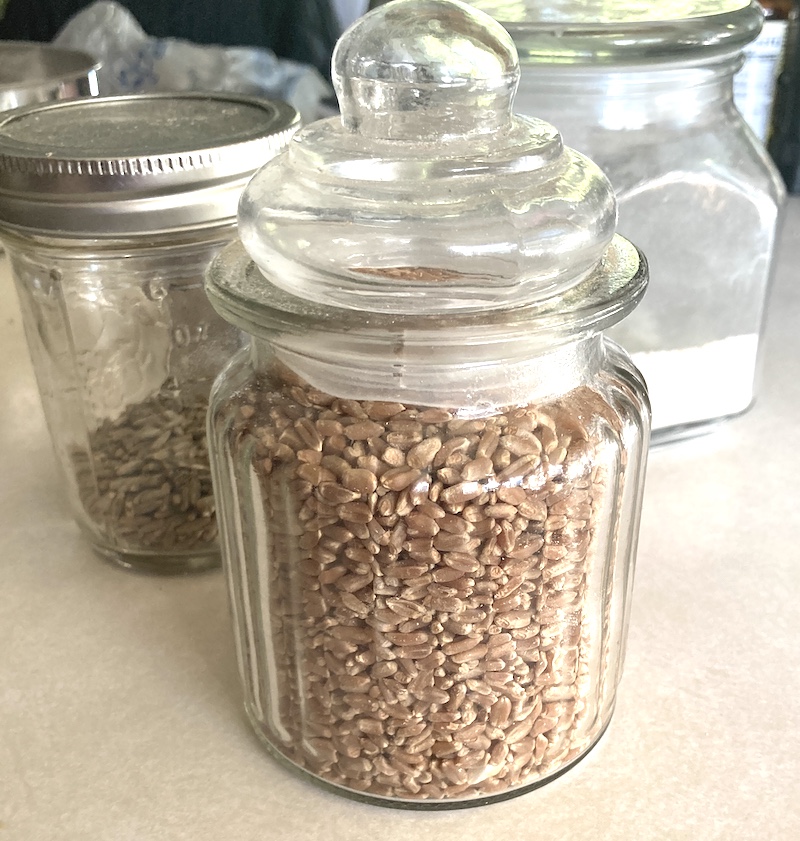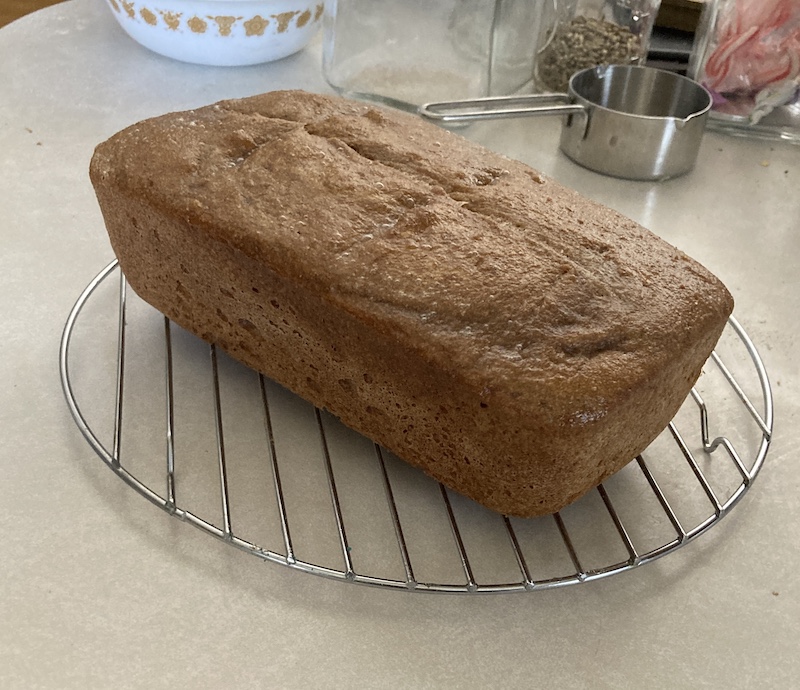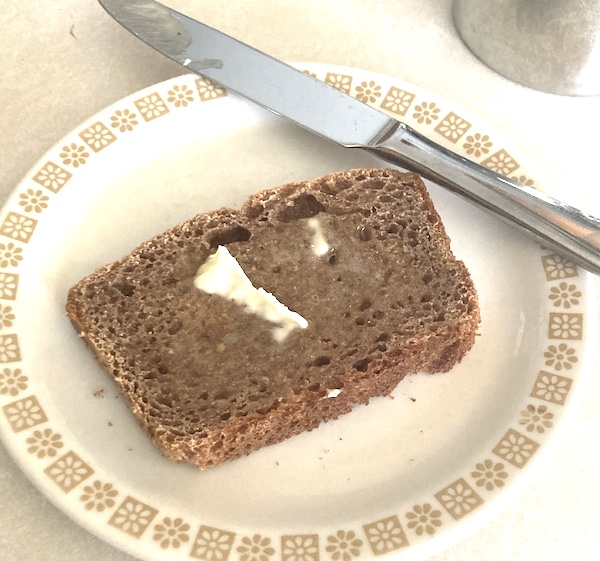
Wheat “berries” (the raw grain) are often recommended as a long-term food storage staple. If you started to need that long-term wheat, what would I do with it? Bake bread, yes, but what would that be like?
All of the recipes I’ve come across for “wheat bread” call for a little whole wheat flour added to (mostly) regular flour — sometimes barely a trace of whole wheat. Ever since covid caused a shortage of yeast, I’ve been baking “sourdough” whole wheat loaves. I’ve tended to use half fresh-ground whole wheat and half commercial flour.
While I have a supply of commercial flour laid back, what if I couldn’t get more? What if commercial flour became scarce — maybe a result of crop failures or shipping trouble (too-expensive fuel), or some other snafu?
What if I had only my hard red wheat berries to make bread from? What would that be like? I decided to find out. I baked a loaf of bread using only the flour I got from grinding my wheat berries, some water, and a tablespoon of salt. I used my sourdough starter as the leavening agent, but that’s made up of only my own ground wheat and water. No commercial yeast.

My fresh-ground wheat flour isn’t prone to the gooey elasticity that pure bread flour dough can have. Mine has all the bran still in it. I’ve read that bran tends to cut the long gluten chains so flour with bran in it won’t be as elastic. Whether the bran-cut gluten is true or not, my pure wheat dough was stiff and didn’t rise much.
My experiment was a small loaf. I went roughly half and half — a cup and a half of fresh-ground wheat flour and a cup and a half of my starter. I figured my all-wheat loaf needed more leavening. (plus a Tbsp of salt and enough water for a workable dough.)
The result was a darker, denser loaf. It did not rise as much as my loaves with commercial flour did. The crumb was pretty good, given the ingredients. It did taste quite wheaty, which I don’t mind. Warmed in a toaster, with a little butter, it was a hearty little slice.
Kommissbrot

My resulting loaf reminded me of Kommissbrot — a similar looking dark bread that was a German military ration during World War I. The recipe is likely older but studying WWI is when I became aware of it. The dense wheat & rye bread was a simple, hearty food with a good shelf life (for a bread before the age of preservatives).
After the war, Kommissbrot became a civilian staple too, what with the economic collapse of the Weimar Republic.
At its simplest, Kommissbrot is just a mix of rye and wheat flours, some salt, and sourdough starter. Civilian bakeries gussied it up for fussier civilian pallets by adding a little cocoa powder, some brown sugar or dark honey. Or, by adding spices traditional for rye breads like caraway, fennel seed, or anis.
Kommissbrot Challenge
Do you have a supply of wheat berries? Try baking a loaf of bread using only your home-ground wheat. See what you get? Odds are, you’ll make your own version of Kommissbrot.
If the supply chain and harvest troubles continue, we could be seeing more of these dark little loaves in our meal plans.


Have been making WW bread from my freshly ground wheat berries for over 10 years. I do, however, use yeast. Turns out like regular bread.
Made chocolate cupcakes – WWII recipe using no milk or eggs – for my son’s family while they visited, everyone thought they were delicious. Used my WW flour.
As it’s the only flour I have used for those 10+ years, maybe I’m just used to how everything turns out and I think it’s normal.
Excellent news, Bellen. Do you sift out the bran? I was doing that for a while to yield a lighter flour. Which grain mill do you use?
— Mic
Sift out the bran? Why would I do more work than is necessary? And, it’s where the nutrition is found – B vitamins, fiber, minerals.
I typically grind about 6 cups of wheat berries at a time, takes about 4 minutes. Whatever I don’t use immediately I put in the freezer – I make sure to warm up the flour before using.
I use a Nutrimill on the medium setting.
Thanks for the reply, Bellan.
I sifted the bran out for a while in order to get a “lighter” flour, hoping to get more rise in my dough. I wondered if anyone did that.
Used the bran to make bran muffins so it didn’t go to waste. But yeah, it’s an unnecessary extra step. Less bran didn’t make much difference for me.
How long did you proof (rise) the dough before baking? I’ve been making sourdough breads etc for a few years and it needs longer rise time than yeast (12 hours)
Hi Karen,
With my routine/recipe I let the dough rise in the bread pan for about four hours. I use a fair mount of starter. Here’s my routine:
– I get my quart jar of starter out of the fridge the night before baking. It’s usually between half and 3/4 full of starter. (fed every 3 or 4 days)
– Before bed, I feed the starter a 1/2 c of fresh ground whole wheat and enough water to keep the batter-like consistency.
– In the morning, I feed the starter another 1/2 c and water for consistency. (this is sometimes half rye and half wheat)
– After a couple hours (time varies with kitchen temp.) the starter has risen to the top of the quart jar. Time to mix dough.
– 2 cups of flour (bread or all-purpose) to 2 cups of starter. 1 Tbsp salt. Enough water for a slightly sticky dough (1/2c +)
If too sticky, add a bit more flour.
As you can see, I use a lot of starter to help it rise faster.
– knead and stretch dough 5 or 6 times. No special number. Feeling for dough to relax and not fight the stretch.
– Form into log-shape and place in greased bread pan. I cover mine with loose cling wrap to keep the top crust from drying too much
– Let rise 4 or so hours (depends on kitchen temp.) I’ll use a slightly warmed oven in winter, temp ~100.
– When risen enough (poke test), bake at 350 for 50 min.
Hope this helps.
— Mic